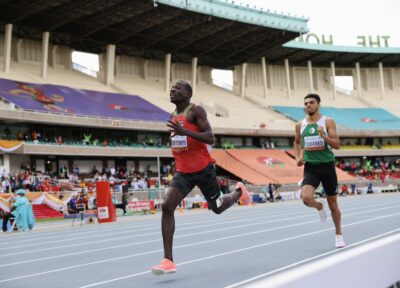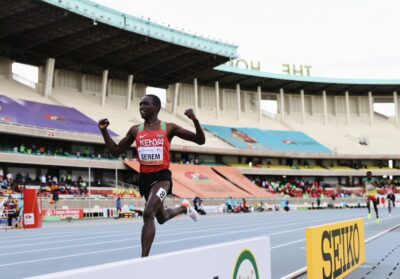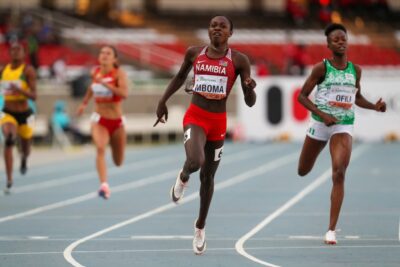What You Missed from 2021 World Juniors: Sasha Zhoya Could Be a Megastar, Christine Mboma Dominates, & All Hail Team Kenya
By Jonathan Gault
August 24, 2021
Last week’s World Athletics U20 Championships — aka World Juniors — got a little overshadowed here in the USA. Between the time difference between the US and Kenya, the absence of American athletes, and the fact that one of the biggest meets of the year took place on US soil last weekend, it’s understandable if you didn’t get to see much of World Juniors. But a bunch of things happened that are worth discussing. Here are a few of the biggest takeaways from five days of action at Kasarani Stadium in Nairobi, Kenya.
Sasha Zhoya could be a megastar
Before the meet we told you to watch out for Zhoya, and the 19-year-old Australian/Zimbabwean/French hurdler did not disappoint. Zhoya, who represents France, entered the meet with the world U20 record in the 60 hurdles (7.34) and a 13.02 pb over the junior height (39 inches) in the 110 hurdles, #4 on the all-time U20 list.
Over the course of 25 hours, Zhoya didn’t just break the world U20 record. He obliterated it. In the semis, Zhoya took the record from 12.99 to 12.93 — into a -0.4 headwind. In the final, Zhoya caught a favorable but legal tailwind of +1.0 and roared to a stunning 12.72, which means he is now .27 of a second faster than anyone in history over the junior hurdles. Ignoring barrier height, this was also the fastest 110 hurdle time ever run — better than Zhoya’s world U18 record of 12.87 and Aries Merritt‘s senior WR of 12.80.
Zhoya’s effort earned the respect of senior world champion Grant Holloway, who reached out later with a friendly DM.
Someone show him this tweet & that I need to have a word with him. 🤯 https://t.co/9IqP4Al406
— S. Grant Holloway, OLY (@Flaamingoo_) August 21, 2021
Is it too early to start salivating over Holloway vs. Zhoya? Clearly both are humongous talents, and they could have a nice home-and-home series coming up with the US hosting Worlds next year and France hosting the Olympics in 2024. By that point Zhoya will be 22, close to his prime, and perhaps one of the faces of the Paris Olympics.
Zhoya has officially conquered all comers at the junior level. His next challenge will be making the step up to the senior hurdles, which are 42 inches rather than 39 — and which the 6-foot-0 Zhoya has never raced over, according to his World Athletics profile.
Kenya dominates the medal table
World Juniors was the biggest track meet ever hosted in Kenya, and the host nation took it seriously, entering strong teams across the board. The result was a dominant performance on home soil, with Kenya leading the way in golds with eight (no other country won more than four) and total medals with 16 (Ethiopia was second with 12).
The absence of some traditional track powers such as the US may have padded those totals slightly — Kenya won bronzes in the men’s 4×400 and women’s 400, events where the US usually medals — but not much as Kenya earned 13 of 16 medals in the distance events (14 of 16 if you count gold in the men’s 10k race walk).
Among those 16 medals, there were some truly impressive performances, none greater than Emmanuel Wanyonyi‘s 1:43.76 to win the men’s 800. Wanyonyi’s time broke Nijel Amos‘ 1:43.79 championship record (set a month before Amos ran 1:41.73 in the Olympic final), and the most impressive part is Wanyonyi’s age: he only turned 17 on August 1. He’s now the second-fastest U18 athlete in history, behind only 2013 world champion Mo Aman of Ethiopia (1:43.37).
Wanyonyi wasn’t the only Kenyan to run well as Kenyans won four of the five men’s distance races in Nairobi (Ethiopia’s Tadese Worku won the 3,000). In the 1500, Vincent Keter upset Kenyan Olympic Trials runner-up Kamar Etiang to win in 3:37.24. Keter is a native of Bomet in southwestern Kenya, the same hometown as Timothy Cheruiyot. Now he trains with Cheruiyot at the Rongai Athletics Club (RAC) under coach Bernard Ouma, and his win gave RAC yet another global 1500m title. Since 2017, RAC has claimed five of the six global outdoor men’s 1500 titles on offer: 2017 World U18s (George Manangoi), 2017 Worlds (Elijah Manangoi), 2018 World U20s (George Manangoi), 2019 Worlds (Timothy Cheruiyot), and 2021 World U20s (Vincent Keter). Only the 2021 Olympic title, where Cheruiyot took silver, has eluded the club.
The men’s 5,000 also saw a terrific starring performance as Kenya’s Benson Kiplangat ran 13:20.37 to hold off Tadese Worku of Ethiopia (13:20.65) — though to be fair to Worku, he had run 7:42.09 to win the 3k the day before, an incredible double when you factor in Nairobi is situated at nearly 6,000 feet of elevation.
The winning time in the steeple was not as fast (8:30.72), but the winner Amos Serem should get the Kenyan fans excited as he demonstrated two traits reminiscent of their last two Olympic champions in the event, Ezekiel Kemboi and Conseslus Kipruto: a blazing final 200, and an affinity for showboating (check out his last lap here).
Serem, who is coached by Patrick Sang (coach of Eliud Kipchoge and 2008 Olympic champ/second-fastest steepler ever Brimin Kipruto), is also eager to reclaim the Olympic steeple title for his country — an event in which Kenya had not been beaten since 1964 until Morocco’s Soufiane El Bakkali won in Tokyo.
“I picked steeplechase because it is the race of Kenyans,” Serem told World Athletics. “I was only going to rest after I earned the world champion title. I am a huge fan of Ezekiel Kemboi. If you are keen you will notice that my running style is very similar to his. I am grateful that my coach Patrick Sang believed in me and moving forward, I can only hope that I will help my country reclaim the Olympic title.”
On the women’s side, Kenya won three of the five distance events, but the times were relatively slower. Purity Chepkirui won the 1500 in 4:16.07, Teresia Gateri won the 3,000 in 8:57.78, and Jackline Chepkoech won the steeple in 9:27.40. Chepkoech’s win was the most dominant of the three as she crushed Olympic 8th placer Zerfe Wondemagegn of Ethiopia by 7+ seconds.
When an athlete wins at World Juniors, the logical eventual goal is the senior world/Olympic title. But translating junior success to senior success can be tough. For one thing, the competition pool is much wider as there are no age restrictions. And then there are athletes in your age group who make big improvements. Neither Selemon Barega nor Jakob Ingebrigtsen won gold at World Juniors in 2018 — Barega didn’t even medal — but both were Olympic champs three years later.
Which means we should be careful in making projections based on the results in Nairobi. This was the fourth consecutive World Juniors in which Kenya swept the men’s 800 and 1500. Just one of those men has gone on to win a senior medal — 2016 800 champ Kipyegon Bett, who took bronze at the 2017 Worlds and was promptly popped for EPO the following year. Outside of Bett, only one of the 22 Kenyan men to have medalled at World Juniors between 2014 and 2018 has won a senior medal: Rhonex Kipruto, who won the World U20 10,000 title in 2018 and earned bronze at the 2019 Worlds in Doha.
DSD athletes Christine Mboma & Beatrice Masilingi combine to win five medals
Last week showed that the topic of DSD (Differences of Sexual Development) athletes in track is not going away anytime soon. DSD athletes are classified by World Athletics as those who are legally female or intersex but have XY chromosomes, testes instead of ovaries, and testosterone levels within the typical male range and as such, cannot compete in events between 400 meters and the mile without reducing their testosterone.
The DSD news began last Tuesday when World Athletics issued a correction to the 2017 paper that was the basis for its DSD regulations. On Friday, DSD athlete Francine Niyonsaba destroyed 5k Olympic silver medalist Hellen Obiri and 5k world record holder Letesenbet Gidey to win the 2-mile at the Pre Classic. And in Nairobi, Namibians Christine Mboma and Beatrice Masilingi, prevented from running the 400 due to the DSD regulations, won five medals in the short sprints.
Masilingi ran 11.39 in the 100 to finish second behind Jamaica’s Tina Clayton, who won the race in 11.09 (Masilingi also ran a Namibian record of 11.20 in the prelims). In the 200, Mboma and Masilingi went 1-2, with both women crushing the championship record of 22.50 (Mboma, the Olympic silver medalist, ran 21.84, Masilingi 22.18; bronze medalist Favour Ofili of Nigeria ran 22.23, over a second ahead of fourth). Finally the two teamed up in the 4×100 relay to earn silver behind Jamaica, which ran a world U20 record of 42.94, with Mboma splitting 9.86 on the anchor.
The next year will be a critical one for DSD athletes in track. One could argue the success of Niyonsaba (who was also 5th in the Olympic 10,000), Mboma, and Masilingi in events outside the 400 to mile window shows World Athletics’ regulations need to be expanded. Or you could go the other way and say that the flawed data behind WA’s 2017 paper means the regulations should be dropped entirely. There are definitely a number of fans who would like to see Caster Semenya race Athing Mu…
Finally, officials use (some) common sense
World Athletics Technical Rule 17.3.2 has become perhaps the most infamous rule in track & field. It states that: In all races (or any part of races) not run in lanes, an athlete running on a bend, on the outer half of the track as per Rule 17.5.2 of the Technical Rules, or on any curved part of the diversion from the track for the steeplechase water jump, shall not step or run on or inside the kerb or line marking the applicable border.
Translation: don’t step inside the rail on a turn.
The intent of the rule is obvious: World Athletics doesn’t want people cutting the turn and running less distance. But in practice, it has mostly been used to punish athletes who accidentally step inside the rail. Very often, these athletes do so because of a momentary lapse in balance or concentration. They step inside/on the rail to stay on their feet, not to run less distance. But their penalty is the same as someone who cuts off the entire turn: disqualification.
It happened to Francine Niyonsaba at the Olympics and it happened again to three athletes at World Juniors. And there’s good news and bad news. The good news is that two of those athletes, women’s 5,000m silver and bronze medalists Melknat Wudu of Ethiopia and Prisca Chesang of Uganda, were reinstated upon appeal. But Kamar Etiang, the bronze medalist in the men’s 1500, was DQ’d and his DQ held up.
The difference between the Wudu and Chesang incident (see here) and the Etiang incident is that it appears there may have been contact between Wudu and Chesang, while Etiang clearly lost his balance of his own accord. But none of the three should have been DQs. Yes, Etiang broke the rule, but it’s a bad rule. Technical Rule 17.3.2 needs to be amended to allow officials to apply some common sense. Etiang lost his balance took one step on the infield. That is not why he finished a second ahead of fourth place.
There is a precedent here in another sport. In the NFL, gunners on kick returns can’t leave the field. But if you are blocked out of bounds by an opponent, you are allowed to leave the field of play as long as you return to the field of play as soon as possible. “As soon as possible” requires the officials to make a judgment call, but that is what they are paid to do in most sports.
The same thing needs to happen with regards to Technical Rule 17.3.2. If an athlete takes a bunch of steps inside the rail or is judged to have stepped inside the rail to run extra distance or in an attempt to pass someone, by all means DQ them. But DQing someone for one accidental step inside the rail that doesn’t affect the outcome of the race needs to stop.











